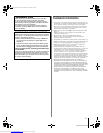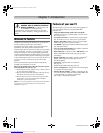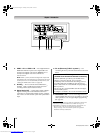
2
MX196 (E/F) Web 213:276
FCC Declaration of Conformity
Compliance Statement
(Part 15):
The Toshiba 62MX196 and 72MX196 Televisions comply
with Part 15 of the FCC rules.
Operation is subject to the following two conditions: (1) this
device may not cause harmful interference, and (2) this device
must accept any interference received, including interference that
may cause undesired operation.
The party responsible for compliance to these rules is:
Toshiba America Consumer Products, L.L.C.
82 Totowa Rd. Wayne, NJ 07470.
Ph: 1-800-631-3811
Note: This equipment has been tested and found to comply
with the limits for a Class B digital device, pursuant to Part 15
of the FCC rules. These limits are designed to provide
reasonable protection against harmful interference in a
residential installation. This equipment generates, uses, and
can radiate radio frequency energy and, if not installed and
used in accordance with the instructions, may cause harmful
interference to radio communications. However, there is
no guarantee that interference will not occur in a particular
installation. If this equipment does cause harmful interference
to radio or television reception, which can be determined by
removing and applying power to the equipment, the user is
encouraged to try to correct the interference by one or more of
the following measures:
• Reorient or relocate the receiving antenna.
• Increase the separation between the equipment and the
receiver.
• Connect the equipment into an outlet on a circuit different
from that to which the receiver is connected.
• Consult the dealer or an experienced radio/TV technician for
help.
Caution: Changes or modifications to this equipment not
expressly approved by Toshiba could void the user’s authority
to operate this equipment.
Important notes about your
DLP
®
projection TV
1) The light source for this TV is a projection lamp unit with a
limited service life. When the lamp wears out, the picture
may become dark or black or the lamp may fail, at which time
you must replace the lamp unit (- “Lamp unit replacement
and care” on pages 84–86).
2) When the lamp mode is set to Low Power, every time the
TV is powered on, the lamp will initially be in High Bright
mode but will switch to Low Power mode after a short
period of time. You may notice a change in screen brightness
when this happens. This is normal and is not a sign of
malfunction (- page 57 for details).
3) Every time the TV is powered on, it may take several minutes
for the picture to obtain full brightness (- “IMPORTANT
NOTICE ABOUT HOT LAMP RESTART,” on the next
page).
4) The TV’s display is manufactured using an extremely high
level of precision technology; however, an occasional pixel
(dot of light) may show constantly on the screen. This is a
structural property of DLP
®
(Digital Light Processing
®
)
technology and is not a sign of malfunction. Such pixels are
not visible when the picture is viewed from a normal viewing
distance.
5) Always sit approximately 10–25 feet away from the TV and
as directly in front of it as possible. The picture quality may
be affected by your viewing position and length of viewing
time. If you sit too closely to the TV for too long, you may
suffer from eye fatigue. See item 29 under “Care” on page 4
of the separate Installation Guide.
6) Depending on the media you are viewing, it is possible,
although unlikely, that a limited number of viewers may see
a “rainbow effect” on the screen, which can, in rare instances,
result in eye fatigue. This is a rare occurrence related to DLP
technology and is not a sign of TV malfunction.
7) This TV contains several cooling fans to moderate
the internal temperature. You may be able to hear
the fans for several minutes after the TV is turned
off. This is a function of the Quick Restart
™
feature and is not a sign of TV malfunction. You can set
the Quick Restart
™
feature to stop the fans as soon as the TV
is powered off. See “Setting the Quick Restart
™
feature” (-
page 30).
8) The yellow and blue LED lights at the bottom center of the
TV front indicate your TV’s current status. If either light
flashes, see “LED indications” (- page 83).
9) Every time the TV power cord is plugged in, the yellow LED
will blink until the TV enters standby mode (plugged in but
not powered on). This is normal and is not a sign of
malfunction.
CAUTION: This television is for use only with
the Toshiba stand indicated below. Use with other
carts or stands is capable of resulting in
instability, causing possible injury.
Television
Stand Model
62MX196 ST 6296
72MX196 ST 7296
MX196_EN.book Page 2 Tuesday, June 27, 2006 1:43 PM
Downloaded from www.Manualslib.com manuals search engine


















